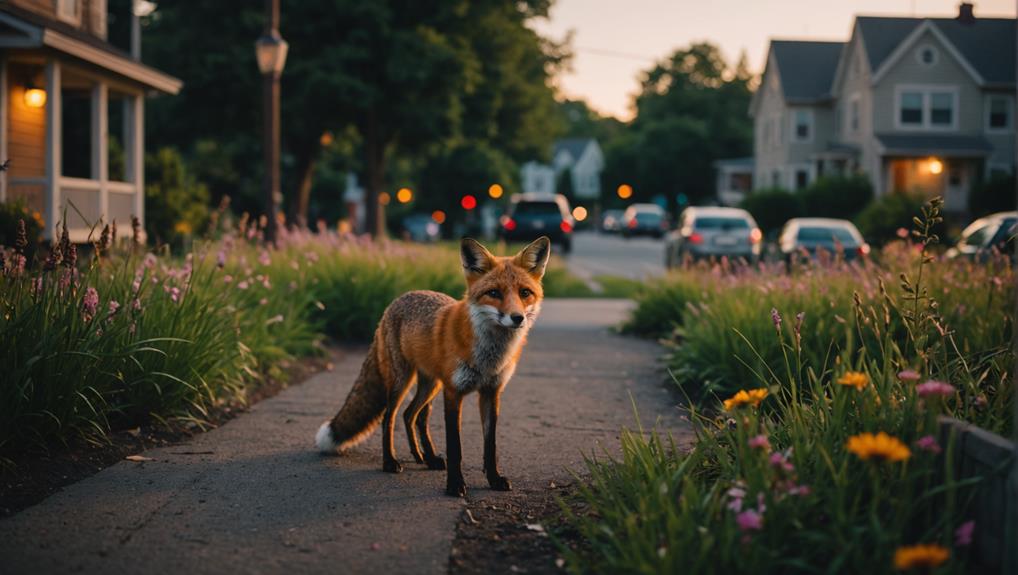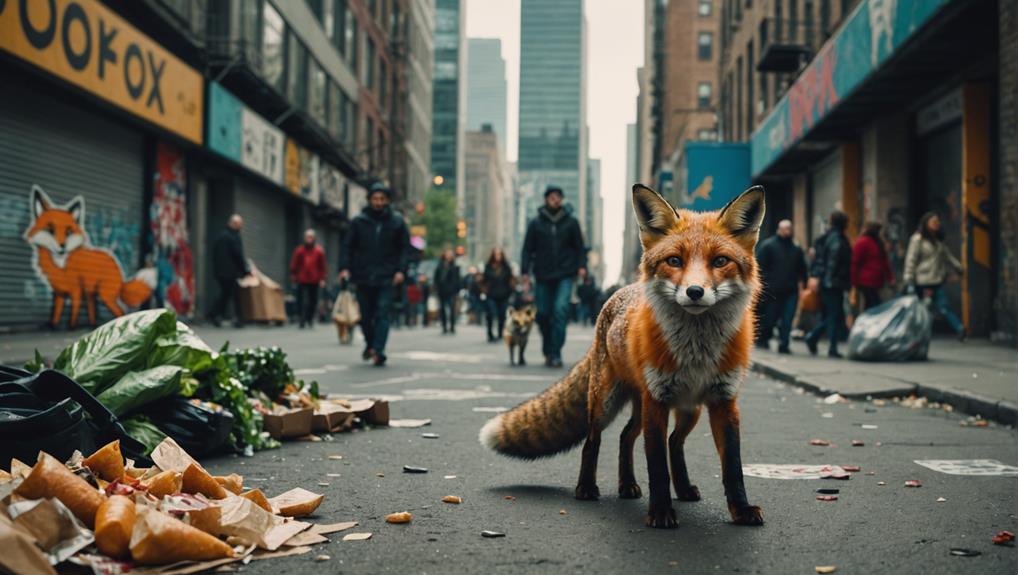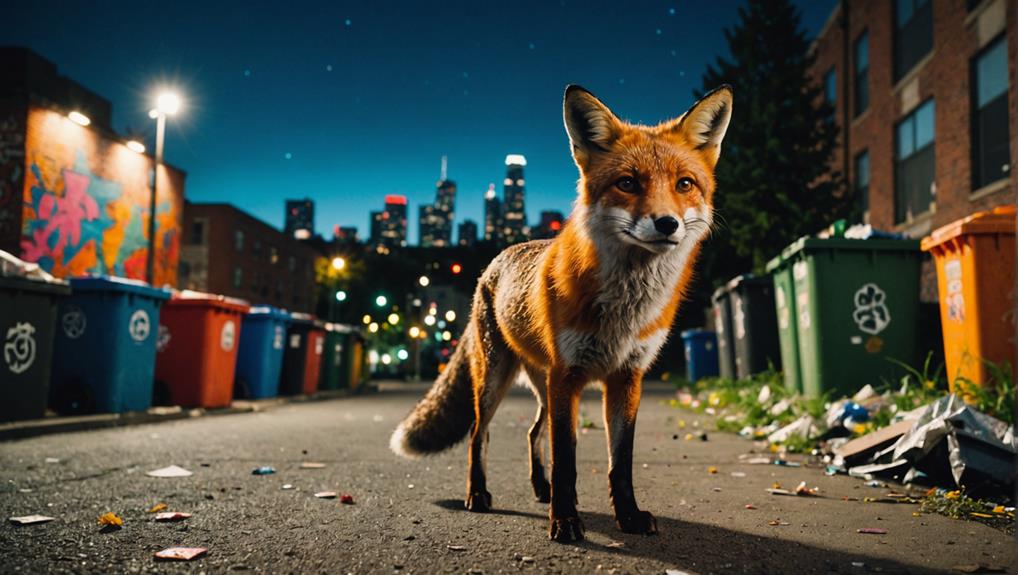In 2024, urban foxes are grabbing the spotlight in our cities! These clever critters are thriving in parks and gardens, where they've become expert scavengers, turning human leftovers into gourmet meals. With shorter snouts and bolder attitudes, they're adapting to city life like pros. You'll spot them exploring green spaces and residential areas, especially at night when they avoid humans. But, there are challenges, like habitat loss and food competition. Thankfully, communities can help by creating safe wildlife corridors. Stick around, and you'll discover more about how these fascinating foxes are navigating our urban jungles!
Contents
- 1 Overview of Urban Foxes
- 2 Adaptation Strategies of Urban Foxes
- 3 Types of Urban Habitats
- 4 Human-Fox Interaction Dynamics
- 5 Challenges for Urban Fox Populations
- 6 Conservation Strategies for Urban Foxes
- 7 Behavioral Flexibility in Urban Environments
- 8 Future Research Directions on Urban Foxes
- 9 Final Thoughts
Overview of Urban Foxes
Urban foxes, particularly the red fox (Vulpes vulpes), thrive in cities like London, where they've skillfully adapted to urban life.
You might be surprised to learn how these clever creatures take advantage of our human population and the anthropogenic food sources we leave behind. Instead of hunting small mammals like their rural cousins, urban red foxes have become expert scavengers, foraging through bins and snatching up leftovers.
Living in urban environments has even changed their physical traits! Studies show they've shorter snouts and larger skulls compared to rural foxes, suggesting they've evolved to better suit their city lifestyle.
Their boldness is another fascinating aspect; they're more likely to explore new things and approach unfamiliar objects than foxes living in the countryside.
However, this close interaction with humans can sometimes lead to perceived nuisance behaviors, like rummaging through gardens or parks.
That's where we come in! Educating ourselves and others about these remarkable animals can help us coexist peacefully, allowing us to appreciate the wild side of city life while minimizing conflicts.
Adaptation Strategies of Urban Foxes
Adapting to city life, urban foxes have developed a range of strategies that enhance their survival in bustling environments.
You might be surprised at how these clever creatures thrive right under our noses! Here are some key ways urban foxes show their adaptability:
- Boldness with Humans: Unlike their rural cousins, urban foxes are bolder, often approaching new objects and people without hesitation.
- Scavenging Skills: They've become experts at foraging, diving into waste bins, and exploring parks for tasty human-associated food sources.
- Home Sweet Home: Urban foxes cleverly utilize public green spaces for denning, making city parks their own cozy retreats.
- Physical Changes: You might even notice that some urban foxes have shorter snouts and larger skulls—adaptations that help them take advantage of the abundant food around.
Types of Urban Habitats

When you think about where urban foxes make their homes, parks, gardens, and even your neighborhood can come to mind.
These clever creatures adapt to residential areas, snatching up leftover food and finding cozy spots to rest.
Plus, they don't shy away from commercial zones, where they might just steal a snack or two from an unsuspecting passerby—talk about a city slicker!
Urban Green Spaces
Green spaces in cities—like parks, gardens, and planted areas—play a crucial role in supporting urban fox populations. These areas not only provide a place for red foxes to roam but also serve as vital foraging grounds.
Here's how urban green spaces help these clever canines thrive:
- Diverse Food Sources: You'll find small mammals, fruits, and even the occasional leftover pizza slice, giving foxes plenty of options.
- Safe Cover: These spaces offer essential hiding spots, making it easier for foxes to stalk their prey species.
- Wildlife Corridors: Connecting green spaces allows foxes to travel and mingle, enhancing genetic diversity and adaptability.
- Community Engagement: By maintaining these green spots, you're helping foster a welcoming environment for urban wildlife, including our furry friends.
As urbanization continues, proper management of these green spaces becomes vital.
When you support efforts to maintain them, you're not just helping red foxes; you're contributing to a healthier ecosystem.
Residential Areas Adaptation
Urban areas are increasingly becoming homes for red foxes, as they cleverly exploit the resources found in residential settings. These urban red foxes have adapted to our neighborhoods, turning gardens, parks, and green spaces into their playgrounds.
They've got a knack for finding food, whether it's leftover pet food or garden waste. Who knew that a little leftover pizza could attract such crafty creatures?
As these foxes settle in, their behavioral patterns shift too. You might notice them being more active at night, skirting around human activity to avoid competition. It's like they've traded in the daylight for a more peaceful moonlit lifestyle.
Interestingly, urban foxes tend to have shorter snouts and broader skulls compared to their country cousins. This suggests their bodies are adapting to the unique challenges of city living.
It's amazing to witness how these animals thrive in high-density areas. Their success reflects a remarkable shift in habitat use and survival strategies.
Commercial Zone Interactions
Navigating the hustle and bustle of commercial zones, red foxes have become adept scavengers, taking advantage of the abundant food sources available in these lively areas.
You might spot them rummaging through trash cans or darting between pedestrian foot traffic. Their opportunistic feeding strategies allow them to thrive in this urban landscape, and their adaptability is truly impressive.
Here are some key interactions you might notice:
- Scavenging: Red foxes often feast on discarded food from nearby restaurants and shops.
- Park Foraging: Urban green spaces, like parks, provide vital foraging spots amidst the concrete jungle.
- Nighttime Adventures: To avoid humans, foxes may become more active at night, embracing their inner night owls.
- Social Structures: In competitive settings, they sometimes band together, forming larger groups to share resources.
While these commercial zones can be bustling, they also present challenges for our furry friends.
The high human density alters their behavior, requiring clever adjustments.
Still, red foxes continue to charm us with their resilience and cunning, reminding us of the wild spirit thriving just beyond our sidewalks.
Human-Fox Interaction Dynamics
When you spot a fox rummaging through your trash, you might wonder how we got to this point.
Urban foxes have become pretty savvy, using our food waste to thrive in the city, and that's led to some interesting interactions.
While some folks find them charming, others see them as a pesky nuisance, reminding us that learning to coexist with these clever creatures is more important than ever.
Urban Resource Exploitation
As cities expand and human activities intensify, red foxes have adapted remarkably to urban life by exploiting the diverse food resources available.
You might be surprised to learn just how resourceful these urban red foxes can be! They've developed opportunistic feeding habits that allow them to thrive in our bustling neighborhoods.
Here are some of their favorite food sources:
- Human refuse: Trash cans and dumpsters are like buffets for these clever creatures.
- Pet food: Leftover kibble in bowls can attract hungry foxes looking for a quick snack.
- Garden produce: Those ripe tomatoes and berries? Foxes see them as a tasty treat!
- Bird feeders: Seeds and suet can draw foxes in, especially if they're feeling adventurous.
This shift in food sources has led to increased interactions with humans.
You might even spot a bold fox rummaging through your garbage! As foxes become more comfortable in urban settings, it's essential to educate ourselves about coexistence strategies.
By fostering a respectful relationship with these fascinating animals, we can create a balance that benefits both wildlife and people.
Behavioral Adaptations in Cities
Urban red foxes have adjusted their behaviors in fascinating ways to thrive alongside humans. You might notice these clever creatures getting bolder, even touching new food-related materials more often than their rural cousins. This playful curiosity is a behavioral response to the bustling urban environment, where they've become quite the scavengers.
In cities, urban red foxes rely heavily on human food scraps, which shapes how they interact with us. Instead of just hunting, they've learned to navigate the complexities of urban life, showcasing their adaptability. It's almost like they've enrolled in a survival course, mastering the art of finding food in the most unexpected places.
Interestingly, while they're bold, urban foxes sometimes lack those fancy problem-solving skills you'd expect. Still, they've developed a knack for teamwork, relying on social structures to share resources.
They know how to work together, making it easier to tackle the challenges city life throws their way. So next time you see an urban red fox, remember, they're not just surviving; they're thriving, adapting, and showing us just how clever they can be in this wild urban jungle!
Challenges for Urban Fox Populations

Amid the sprawling concrete landscapes, urban fox populations grapple with significant challenges that threaten their survival. As they navigate the bustling city life, these clever creatures face numerous hurdles that make life tough. Here's a closer look at some of the biggest challenges:
- Habitat Loss: Ongoing urbanization diminishes their natural homes, making it harder for them to find safe places to live and raise their young.
- Food Competition: With more people around, urban foxes compete fiercely for food. They often resort to rummaging through trash cans, which isn't exactly gourmet dining!
- Human-Wildlife Conflicts: Their scavenging habits can lead to trouble, like raiding backyard chickens or causing a ruckus in neighborhoods—definitely not the best way to win friends.
- Health Issues: Pollution and stress from urban life can impact their health and even reduce the survival rates of cute little cubs.
These challenges complicate their foraging strategies and shift predator-prey dynamics, making it increasingly difficult for urban foxes to thrive.
Understanding these issues is a step toward helping them survive amidst our concrete jungles.
Conservation Strategies for Urban Foxes
While many might view urban environments as inhospitable to wildlife, effective conservation strategies can significantly improve the chances of urban foxes thriving in these settings. One key approach is creating wildlife corridors. These safe passageways help foxes move between green spaces, reducing the likelihood of conflicts with humans.
Think of it as their version of a freeway—but much cuter!
Public education is another vital piece of the puzzle. By clearing up misconceptions about urban foxes, you can help foster understanding and tolerance. Remember, not every fox is out to steal your lunch!
Habitat preservation also plays a critical role. Protecting and enhancing existing green spaces ensures urban foxes have access to the resources they need to survive.
Monitoring urban fox populations is essential, too. This gives valuable insights into their health and adaptability, which can inform future urban planning and conservation measures.
Lastly, incorporating wildlife considerations into urban development projects ensures that the needs of urban foxes and other wildlife are prioritized.
Behavioral Flexibility in Urban Environments

Adapting to urban life requires foxes to exhibit remarkable behavioral flexibility. Urban red foxes have become quite bold, often taking risks that their rural cousins wouldn't dream of. This boldness helps them thrive, but it comes with a twist—while they touch new objects frequently, they don't always figure out how to use them.
Here are some fascinating insights into their behavior:
- Encounters with Novelty: Urban foxes often initiate contact with new, food-related materials, showing their curiosity.
- Boldness Over Creativity: These foxes are brave, but they may trade innovative problem-solving for taking risks.
- Urban Pressures: Their willingness to engage with new objects ties directly to living in bustling cities, where adaptability is key.
- Survival Tactics: In an urban jungle, it's all about making quick decisions—sometimes, that means prioritizing bold actions over clever solutions.
Understanding these behaviors helps us appreciate how urban red foxes adapt to their ever-changing environments. It's a wild world out there, and these little creatures manage to navigate it with a mix of courage and cunning!
Future Research Directions on Urban Foxes
Future research on urban foxes promises to unveil crucial insights into their adaptation strategies and ecological roles. By digging into genomic analysis, we can identify the heritability of traits like skull shape and dentition changes that help urban red foxes thrive in city life. Imagine how cool it'd be to understand what makes these clever critters so resilient!
Exploring the impact of anthropogenic food sources on their foraging behavior could shed light on how human activities are reshaping their diets. You'd be amazed at how flexible these foxes can be!
Also, studying their social structures could reveal how urban fox communities tackle unique challenges together. After all, teamwork makes the dream work, even in the wild!
Longitudinal studies to keep tabs on urban fox populations will provide vital data on their health and resilience as city landscapes evolve.
Final Thoughts
So, there you have it! Urban foxes are fascinating creatures, adapting to city life in ways that often surprise us. While they face challenges, like traffic and human interactions, their cleverness and flexibility shine through. By understanding and respecting these furry neighbors, we can help ensure they thrive alongside us. Let's keep our eyes peeled for these little urban adventurers and appreciate the wild side of our cities. After all, who wouldn't want a fox as a neighbor?














